Prospects for the Valorization of Wind Turbine Blade Waste: Fiber Recovery and Recycling
Abstract
1. Introduction
2. Management Aspects of Wind Turbine Blade Waste (WTBW)
3. Sustainability Challenges in the Construction Industry
4. Valorization of Wind Turbine Blade Waste (WTBW)
4.1. Thermal Methods for Glass Fiber Recycling and Recovery
4.1.1. Pyrolysis Process in Fiber Recovery from GFRP
4.1.2. Plasma Method in WTBW Recycling
4.2. Application of Recovered or Recycled Glass Fiber
4.2.1. Mechanically Treated Glass Fiber-Reinforced Polymer (GFRP) in Concrete
4.2.2. WTBW in Geopolymers
4.3. Durability of Recovered or Recycled Glass Fiber
4.3.1. Durability of Glass Fiber Recovered by Pyrolysis
4.3.2. Durability of Recycled Fiber Derived from Plasma Processing
5. Concluding Remarks
Author Contributions
Funding
Data Availability Statement
Acknowledgments
Conflicts of Interest
References
- Liu, P.; Barlow, C.Y. Wind turbine blade waste in 2050. Waste Manag. 2017, 62, 229–240. [Google Scholar] [CrossRef] [PubMed]
- Zhang, W.; Yu, H.; Yin, B.; Akbar, A.; Liew, K.M. Sustainable transformation of end-of-life wind turbine blades: Advancing clean energy solutions in civil engineering through recycling and upcycling. J. Clean. Prod. 2023, 426, 139184. [Google Scholar] [CrossRef]
- Tyurkay, A.; Kirkelund, G.M.; Lima, A.T.M. State-of-the-art circular economy practices for end-of-life wind turbine blades for use in the construction industry. Sustain. Prod. Consum. 2024, 47, 17–36. [Google Scholar] [CrossRef]
- Podara, C.; Termine, S.; Modestou, M.; Semitekolos, D.; Tsirogiannis, C.; Karamitrou, M.; Trompeta, A.F.; Milickovic, T.K.; Charitidis, C. Recent Trends of Recycling and Upcycling of Polymers and Composites: A Comprehensive Review. Recycling 2024, 9, 37. [Google Scholar] [CrossRef]
- Jasińska, D.; Dutkiewicz, M. Waste Management of Wind Turbine Blades—A Review of Recycling Methods and Applications in Cementitious Composites. Sustainability 2025, 17, 805. [Google Scholar] [CrossRef]
- Qureshi, J. A Review of Recycling Methods for Fibre Reinforced Polymer Composites. Sustainability 2022, 14, 16855. [Google Scholar] [CrossRef]
- Tayebi, S.T.; Sambucci, M.; Valente, M. Waste Management of Wind Turbine Blades: A Comprehensive Review on Available Recycling Technologies with A Focus on Overcoming Potential Environmental Hazards Caused by Microplastic Production. Sustainability 2024, 16, 4517. [Google Scholar] [CrossRef]
- Liu, T.; Paraskevoulakos, C.; Mughal, U.A.; Tyurkay, A.; Lushnikova, N.; Song, H.; Duyal, C.; Karnick, S.T.; Gauvin, F.; Lima, A.T. Mechanisms and applications of wind turbine blade waste in cementitious composites: A review. Mater. Des. 2025, 251, 113732. [Google Scholar] [CrossRef]
- Pender, K.; Yang, L. Regenerating performance of glass fibre recycled from wind turbine blade. Compos. Part B Eng. 2020, 198, 108230. [Google Scholar] [CrossRef]
- Rani, M.; Choudhary, P.; Krishnan, V.; Zafar, S. Development of sustainable microwave-based approach to recover glass fibers for wind turbine blades composite waste. Resour. Conserv. Recycl. 2022, 179, 106107. [Google Scholar] [CrossRef]
- Obunai, K.; Fukuta, T.; Ozaki, K. Carbon fiber extraction from waste CFRP by microwave irradiation. Compos. Part A Appl. Sci. Manuf. 2015, 78, 160–165. [Google Scholar] [CrossRef]
- Deng, J.; Xu, L.; Zhang, L.; Peng, J.; Guo, S.; Liu, J.; Koppala, S. Recycling of carbon fibers from CFRP waste by microwave thermolysis. Processes 2019, 7, 207. [Google Scholar] [CrossRef]
- Zhao, X.; Long, Y.; Xu, S.; Liu, X.; Chen, L.; Wang, Y.Z. Recovery of epoxy thermosets and their composites. Mater. Today 2023, 64, 72–97. [Google Scholar] [CrossRef]
- Li, L.; Wang, Y.; Tan, H.; Xiong, X. Pollutant emission during pyrolysis of waste wind turbine blades: Nitrogen-containing components and polycyclic aromatic hydrocarbons. J. Environ. Manag. 2024, 371, 123159. [Google Scholar] [CrossRef]
- Jensen, J.P.; Skelton, K. Wind turbine blade recycling: Experiences, challenges and possibilities in a circular economy. Renew. Sustain. Energy Rev. 2018, 97, 165–176. [Google Scholar] [CrossRef]
- Hasheminezhad, A.; Nazari, Z.; Yang, B.; Ceylan, H.; Kim, S. A comprehensive review of sustainable solutions for reusing wind turbine blade waste materials. J. Environ. Manag. 2024, 366, 121735. [Google Scholar] [CrossRef]
- Khalid, M.Y.; Arif, Z.U.; Hossain, M.; Umer, R. Recycling of wind turbine blades through modern recycling technologies: A road to zero waste. Renew. Energy Focus 2023, 44, 373–389. [Google Scholar] [CrossRef]
- Leon, M.J. Recycling of wind turbine blades: Recent developments. Curr. Opin. Green Sustain. Chem. 2023, 39, 100746. [Google Scholar] [CrossRef]
- Trivyza, N.L.; Tuni, A.; Rentizelas, A. Towards circularity in the wind industry: Optimal reverse supply network design under various policy scenarios. Waste Manag. 2025, 191, 294–307. [Google Scholar] [CrossRef]
- Schindler, A.K.; Duke, S.R.; Galloway, W.B. Co-processing of end-of-life wind turbine blades in portland cement production. Waste Manag. 2024, 182, 207–214. [Google Scholar] [CrossRef] [PubMed]
- Krauklis, A.E.; Karl, C.W.; Gagani, A.I.; Jørgensen, J.K. Composite material recycling technology—State-of-the-art and sustainable development for the 2020s. J. Compos. Sci. 2021, 5, 28. [Google Scholar] [CrossRef]
- Diez-Cañamero, B.; Mendoza, J.M.F. Circular economy performance and carbon footprint of wind turbine blade waste management alternatives. Waste Manag. 2023, 164, 94–105. [Google Scholar] [CrossRef] [PubMed]
- Xu, M.-X.; Ji, H.-W.; Wu, Y.-C.; Meng, X.-X.; Di, J.-Y.; Yang, J.; Lu, Q. Recovering glass fibers from waste wind turbine blades: Recycling methods, fiber properties, and potential utilization. Renew. Sustain. Energy Rev. 2024, 202, 114690. [Google Scholar] [CrossRef]
- Beauson, J.; Laurent, A.; Rudolph, D.P.; Pagh Jensen, J. The complex end-of-life of wind turbine blades: A review of the European context. Renew. Sustain. Energy Rev. 2022, 155, 111847. [Google Scholar] [CrossRef]
- Han, N.; Baran, I.; Zanjani, J.S.M.; Yuksel, O.; An, L.L.; Akkerman, R. Experimental and computational analysis of the polymerization overheating in thick glass/Elium® acrylic thermoplastic resin composites. Compos. Part B Eng. 2020, 202, 108430. [Google Scholar] [CrossRef]
- Paulsen, E.B.; Enevoldsen, P. A multidisciplinary review of recycling methods for end-of-life wind turbine blades. Energies 2021, 14, 4247. [Google Scholar] [CrossRef]
- Madlool, N.A.; Saidur, R.; Hossain, M.S.; Rahim, N.A. A critical review on energy use and savings in the cement industries. Renew. Sustain. Energy Rev. 2011, 15, 2042–2060. [Google Scholar] [CrossRef]
- Supriya; Chaudhury, R.; Sharma, U.; Thapliyal, P.C.; Singh, L.P. Low-CO2 emission strategies to achieve net zero target in cement sector. J. Clean. Prod. 2023, 417, 137466. [Google Scholar] [CrossRef]
- GCCA. Cement Industry Net Zero Progress Report; Global Cement and Concrete Association: London, UK, 2023. [Google Scholar]
- Liu, F.; Ding, W.; Qiao, Y. Experimental investigation on the tensile behavior of hybrid steel-PVA fiber reinforced concrete containing fly ash and slag powder. Constr. Build. Mater. 2020, 241, 118000. [Google Scholar] [CrossRef]
- Mikulčić, H.; Klemeš, J.J.; Vujanović, M.; Urbaniec, K.; Duić, N. Reducing greenhouse gasses emissions by fostering the deployment of alternative raw materials and energy sources in the cleaner cement manufacturing process. J. Clean. Prod. 2016, 136, 119–132. [Google Scholar] [CrossRef]
- Ortega-López, V.; Faleschini, F.; Hurtado-Alonso, N.; Manso-Morato, J.; Revilla-Cuesta, V. Analysis of raw-crushed wind-turbine blade as an overall concrete addition: Stress–strain and deflection performance effects. Compos. Struct. 2024, 340, 118170. [Google Scholar] [CrossRef]
- Manso-Morato, J.; Hurtado-Alonso, N.; Revilla-Cuesta, V.; Skaf, M.; Ortega-López, V. Fiber-Reinforced concrete and its life cycle assessment: A systematic review. J. Build. Eng. 2024, 94, 110062. [Google Scholar] [CrossRef]
- Ginder, R.S.; Ozcan, S. Recycling of commercial E-glass reinforced thermoset composites via two temperature step pyrolysis to improve recovered fiber tensile strength and failure strain. Recycling 2019, 4, 24. [Google Scholar] [CrossRef]
- Deeney, P.; Leahy, P.G.; Campbell, K.; Ducourtieux, C.; Mullally, G.; Dunphy, N.P. End-of-life wind turbine blades and paths to a circular economy. Renew. Sustain. Energy Rev. 2025, 212, 115418. [Google Scholar] [CrossRef]
- Yousef, S.; Eimontas, J.; Zakarauskas, K.; Striūgas, N. Recovery of styrene-rich oil and glass fibres from fibres-reinforced unsaturated polyester resin end-of-life wind turbine blades using pyrolysis technology. J. Anal. Appl. Pyrolysis 2023, 173, 106100. [Google Scholar] [CrossRef]
- Zhang, B.; Zhang, S.; Yang, Z.; Liu, W.; Wu, B.; Huang, M.; Liu, B. Pyrolysis process and products characteristics of glass fiber reinforced epoxy resin from waste wind turbine blades. Compos. Part B Eng. 2024, 287, 111803. [Google Scholar] [CrossRef]
- Zhang, Y.; Zhang, Z.; Ma, W.; Chen, P.; Bai, B.; Li, L.; Lai, Y.; Wang, X. Pyrolysis and oxidation characteristics and energy self-sustaining process design of retired wind turbine blades. J. Anal. Appl. Pyrolysis 2025, 185, 106872. [Google Scholar] [CrossRef]
- Xu, M.-X.; Ji, H.-W.; Wu, Y.-C.; Di, J.-Y.; Meng, X.-X.; Jiang, H.; Lu, Q. The pyrolysis of end-of-life wind turbine blades under different atmospheres and their effects on the recovered glass fibers. Compos. Part B Eng. 2023, 251, 110493. [Google Scholar] [CrossRef]
- Li, L.; Wang, Y.; Wang, M.; Tan, H.; Xiong, X. Collaborative disposal of exhaust gas and waste wind turbine blades: Mechanical properties of recycled glass fibres and economic analysis. J. Clean. Prod. 2024, 471, 143351. [Google Scholar] [CrossRef]
- Cheng, G.; Yang, S.; Wang, X.; Guo, Z.; Cai, M. Study on the recycling of waste wind turbine blades. J. Eng. Res. 2023, 11, 13–17. [Google Scholar] [CrossRef]
- Xu, M.; Yang, J.; Ji, H.; Wu, Y.; Li, J.; Di, J.; Meng, X.; Jiang, H.; Lu, Q. Recovering high-quality glass fibers from end-of-life wind turbine blades through swelling-assisted low-temperature pyrolysis. Waste Manag. 2024, 187, 179–187. [Google Scholar] [CrossRef] [PubMed]
- Rahimizadeh, A.; Tahir, M.; Fayazbakhsh, K.; Lessard, L. Tensile properties and interfacial shear strength of recycled fibers from wind turbine waste. Compos. Part A Appl. Sci. Manuf. 2020, 131, 105786. [Google Scholar] [CrossRef]
- Bosmans, A.; Vanderreydt, I.; Geysen, D.; Helsen, L. The crucial role of Waste-to-Energy technologies in enhanced landfill mining: A technology review. J. Clean. Prod. 2013, 55, 10–23. [Google Scholar] [CrossRef]
- Solis, M.; Silveira, S. Technologies for chemical recycling of household plastics—A technical review and TRL assessment. Waste Manag. 2020, 105, 128–138. [Google Scholar] [CrossRef]
- Mazzoni, L.; Janajreh, I.; Elagroudy, S.; Ghenai, C. Modeling of plasma and entrained flow co-gasification of MSW and petroleum sludge. Energy 2020, 196, 117001. [Google Scholar] [CrossRef]
- Samal, S. Thermal plasma technology: The prospective future in material processing. J. Clean. Prod. 2017, 142, 3131–3150. [Google Scholar] [CrossRef]
- Boulos, M.I.; Fauchais, P.L.; Pfender, E. Handbook of Thermal Plasmas; Springer: Cham, Switzerland, 2023. [Google Scholar] [CrossRef]
- Gimžauskaitė, D.; Tamošiūnas, A.; Aikas, M.; Uscila, R. Thermal plasma potential to remediate soil contaminated with diesel. Environ. Res. 2023, 229, 115976. [Google Scholar] [CrossRef] [PubMed]
- Striūgas, N.; Tamošiūnas, A.; Marcinauskas, L.; Paulauskas, R.; Zakarauskas, K.; Skvorčinskienė, R. A sustainable approach for plasma reforming of tail biogas for onsite syngas production during lean combustion operation. Energy Convers. Manag. 2020, 209, 112617. [Google Scholar] [CrossRef]
- Baturkin, D.; Hisseine, O.A.; Masmoudi, R.; Tagnit-Hamou, A.; Massicotte, L. Valorization of recycled FRP materials from wind turbine blades in concrete. Resour. Conserv. Recycl. 2021, 174, 105807. [Google Scholar] [CrossRef]
- Manso-Morato, J.; Hurtado-Alonso, N.; Revilla-Cuesta, V.; Ortega-López, V. Management of wind-turbine blade waste as high-content concrete addition: Mechanical performance evaluation and life cycle assessment. J. Environ. Manag. 2025, 373, 123995. [Google Scholar] [CrossRef]
- Kavaliauskas, Ž.; Kėželis, R.; Grigaitienė, V.; Marcinauskas, L.; Milieška, M.; Valinčius, V.; Uscila, R.; Snapkauskienė, V.; Gimžauskaitė, D.; Baltušnikas, A. Recycling of Wind Turbine Blades into Microfiber Using Plasma Technology. Materials 2023, 16, 3089. [Google Scholar] [CrossRef] [PubMed]
- Grigaitienė, V.; Uscila, R.; Valinčius, V.; Kėželis, R.; Milieška, M.; Gimžauskaitė, D.; Snapkauskienė, V.; Kavaliauskas, Ž. Possibility of recycling wind turbine blades using plasma technology. WIT Trans. Ecol. Environ. 2022, 257, 65–71. [Google Scholar] [CrossRef]
- Gimžauskaitė, D.; Tamošiūnas, A.; Eimontas, J.; Aikas, M.; Uscila, R.; Snapkauskienė, V. Bituminous Soil Remediation in the Thermal Plasma Environment. Sustainability 2024, 16, 4855. [Google Scholar] [CrossRef]
- Grigaitienė, V.; Kėželis, R.; Valinčius, V.; Valatkevičius, P.; Milieška, M. Numerical and experimental images of multiphase plasma jet during plasma processing of dispersed materials. In Proceedings of the V European Conference on Computational Fluid Dynamics, Lisbon, Portugal, 14–17 June 2010; Available online: https://api.semanticscholar.org/CorpusID:138813350 (accessed on 1 September 2010).
- Tao, Y.; Hadigheh, S.A.; Wei, Y. Recycling of glass fibre reinforced polymer (GFRP) composite wastes in concrete: A critical review and cost benefit analysis. Structures 2023, 53, 1540–1556. [Google Scholar] [CrossRef]
- Revilla-Cuesta, V.; Skaf, M.; Ortega-López, V.; Manso, J.M. Raw-crushed wind-turbine blade: Waste characterization and suitability for use in concrete production. Resour. Conserv. Recycl. 2023, 198, 107160. [Google Scholar] [CrossRef]
- Yazdanbakhsh, A.; Bank, L.C.; Chen, C.; Tian, Y. FRP-Needles as Discrete Reinforcement in Concrete. J. Mater. Civ. Eng. 2017, 29, 04017175. [Google Scholar] [CrossRef]
- Yu, T.; Zhou, C.; Cao, L.; Zhang, Y.; Cao, P.; Shi, F. Effect of GFRP fibres recovered from decommissioned wind turbine blades on the fracture properties of concrete. Constr. Build. Mater. 2025, 463, 140121. [Google Scholar] [CrossRef]
- Abdo, M.; Toumpanaki, E.; Diambra, A.; Comandini, G.; Bank, L. Evaluation of mechanical properties of concrete with recycled FRP wind blade waste material. In Proceedings of the 11th International Conference on Fiber-Reinforced Polymer (FRP) Composites in Civil Engineering, Rio de Janeiro, Brazil, 23–26 July 2023. [Google Scholar]
- Yazdanbakhsh, A.; Bank, L.C.; Tian, Y. Mechanical processing of GFRP waste into large-sized pieces for use in concrete. Recycling 2018, 3, 8. [Google Scholar] [CrossRef]
- Revilla-Cuesta, V.; Manso-Morato, J.; Hurtado-Alonso, N.; Skaf, M.; Ortega-López, V. Mechanical and environmental advantages of the revaluation of raw-crushed wind-turbine blades as a concrete component. J. Build. Eng. 2024, 82, 108383. [Google Scholar] [CrossRef]
- Xu, G.T.; Liu, M.J.; Xiang, Y.; Fu, B. Valorization of macro fibers recycled from decommissioned turbine blades as discrete reinforcement in concrete. J. Clean. Prod. 2022, 379, 134550. [Google Scholar] [CrossRef]
- Fu, B.; Liu, K.C.; Chen, J.F.; Teng, J.G. Concrete reinforced with macro fibres recycled from waste GFRP. Constr. Build. Mater. 2021, 310, 125063. [Google Scholar] [CrossRef]
- Yazdanbakhsh, A.; Bank, L.C.; Rieder, K.A.; Tian, Y.; Chen, C. Concrete with discrete slender elements from mechanically recycled wind turbine blades. Resour. Conserv. Recycl. 2018, 128, 11–21. [Google Scholar] [CrossRef]
- Yazdanbakhsh, A.; Bank, L.C.; Chen, C. Use of recycled FRP reinforcing bar in concrete as coarse aggregate and its impact on the mechanical properties of concrete. Constr. Build. Mater. 2016, 121, 278–284. [Google Scholar] [CrossRef]
- Sorathiya, S.; Patel, P.N.R.; Pitroda, J. A Techno Economical Study on Wind Turbine Blade Waste as Replacement of Natural Coarse Aggregates in Concrete. Int. J. Constr. Res. Civ. Eng. 2017, 3, 26–32. [Google Scholar] [CrossRef]
- Farinha, C.B.; de Brito, J.; Veiga, R. Assessment of glass fibre reinforced polymer waste reuse as filler in mortars. J. Clean. Prod. 2019, 210, 1579–1594. [Google Scholar] [CrossRef]
- Oliveira, P.S.; Antunes, M.L.P.; da Cruz, N.C.; Rangel, E.C.; de Azevedo, A.R.G.; Durrant, S.F. Use of waste collected from wind turbine blade production as an eco-friendly ingredient in mortars for civil construction. J. Clean. Prod. 2020, 274, 122948. [Google Scholar] [CrossRef]
- Rodin, H.; Nassiri, S.; Englund, K.; Fakron, O.; Li, H. Recycled glass fiber reinforced polymer composites incorporated in mortar for improved mechanical performance. Constr. Build. Mater. 2018, 187, 738–751. [Google Scholar] [CrossRef]
- Walkley, B. Geopolymers. In Encyclopedia of Engineering Geology; Encyclopedia of Earth Sciences Series; Springer: Cham, Switzerland, 2018; Volume 37, pp. 1–2. [Google Scholar] [CrossRef]
- Zhao, J.; Tong, L.; Li, B.; Chen, T.; Wang, C.; Yang, G.; Zheng, Y. Eco-friendly geopolymer materials: A review of performance improvement, potential application and sustainability assessment. J. Clean. Prod. 2021, 307, 127085. [Google Scholar] [CrossRef]
- Souza Junior, F.G. de Geopolymer: A Review of Structure, Applications and Properties of Fiber Reinforced Composites. Res. Dev. Mater. Sci. 2018, 7, 752–759. [Google Scholar] [CrossRef]
- Abbas, A.-G.N.; Aziz, F.N.A.A.; Abdan, K.; Nasir, N.A.M.; Huseien, G.F. A state-of-the-art review on fibre-reinforced geopolymer composites. Constr. Build. Mater. 2022, 330, 127187. [Google Scholar] [CrossRef]
- Sambucci, M.; Sibai, A.; Valente, M. Recent Advances in Geopolymer Technology. A Potential Eco-Friendly Solution in the Construction Materials Industry: A Review. J. Compos. Sci. 2021, 5, 109. [Google Scholar] [CrossRef]
- Figiela, B.; Korniejenko, K.; Łach, M.; Azzopardi, B. A study on geopolymer composites based on waste from wind turbine blades. Materwiss. Werksttech. 2022, 53, 467–478. [Google Scholar] [CrossRef]
- Pławecka, K.; Przybyła, J.; Korniejenko, K.; Lin, W.T.; Cheng, A.; Łach, M. Recycling of mechanically ground wind turbine blades as filler in geopolymer composite. Materials 2021, 14, 6539. [Google Scholar] [CrossRef] [PubMed]
- Senff, L.; Novais, R.M.; Carvalheiras, J.; Labrincha, J.A. Eco-friendly approach to enhance the mechanical performance of geopolymer foams: Using glass fibre waste coming from wind blade production. Constr. Build. Mater. 2020, 239, 117805. [Google Scholar] [CrossRef]
- Novais, R.M.; Carvalheiras, J.; Seabra, M.P.; Pullar, R.C.; Labrincha, J.A. Effective mechanical reinforcement of inorganic polymers using glass fibre waste. J. Clean. Prod. 2017, 166, 343–349. [Google Scholar] [CrossRef]
- Zhang, M.; Qiu, X.; Shen, S.; Wang, L.; Zang, Y. Mechanical and Thermal Insulation Properties of rGFRP Fiber-Reinforced Lightweight Fly-Ash-Slag-Based Geopolymer Mortar. Sustainability 2023, 15, 7200. [Google Scholar] [CrossRef]
- Cousins, D.S.; Suzuki, Y.; Murray, R.E.; Samaniuk, J.R.; Stebner, A.P. Recycling glass fiber thermoplastic composites from wind turbine blades. J. Clean. Prod. 2019, 209, 1252–1263. [Google Scholar] [CrossRef]
- Yuan, Y.; Ge, Y.; Yan, J.; Peng, H.; Zhang, B. Synthesis of geopolymer using glass fiber powder from retired wind blades: A new attempt to recycle solid waste in wind power industries. J. Build. Eng. 2024, 95, 110130. [Google Scholar] [CrossRef]
- Yousef, S.; Kalpokaitė-Dičkuvienė, R. Sustainable mortar reinforced with recycled glass fiber derived from pyrolysis of wind turbine blade waste. J. Mater. Res. Technol. 2024, 31, 879–887. [Google Scholar] [CrossRef]
- Kalpokaitė-Dičkuvienė, R.; Čėsnienė, J.; Kriūkienė, R.; Anastasiia, S. Toward sustainable material use: Fiber durability in geopolymer hardening solutions. In Proceedings of the 5th International Conference: Strategies Toward Green Deal Implementation: Water, Raw Materials & Energy in Green Transition: Abstract Book, Krakow, Poland, 27–29 November 2024; Volume 97. Available online: https://files.cdn-files-a.com/uploads/6569390/normal_676555a4b76f6.pdf (accessed on 1 December 2024).
- Zhang, M.; Chang, J. Surfactant-assisted sonochemical synthesis of hollow calcium silicate hydrate (CSH) microspheres for drug delivery. Ultrason. Sonochem. 2010, 17, 789–792. [Google Scholar] [CrossRef]
- Lin, K.; Wu, C.; Chang, J. Advances in synthesis of calcium phosphate crystals with controlled size and shape. Acta Biomater. 2014, 10, 4071–4102. [Google Scholar] [CrossRef]
- Katoh, Y.; Suzuki, M.; Kato, C.; Shinkai, K.; Ogawa, M.; Yamauchi, J. Observation of calcium phosphate powder mixed with an adhesive monomer experimentally developed for direct pulp capping and as a bonding agent. Dent. Mater. J. 2010, 29, 15–24. [Google Scholar] [CrossRef] [PubMed]
- He, P.; Zhang, X.; Chen, H.; Zhang, Y. Waste-to-resource strategies for the use of circulating fluidized bed fly ash in construction materials: A mini review. Powder Technol. 2021, 393, 773–785. [Google Scholar] [CrossRef]
- Pitak, I.; Baltušnikas, A.; Kalpokaitė-Dičkuvienė, R.; Kriukiene, R.; Denafas, G. Experimental study effect of bottom ash and temperature of firing on the properties, microstructure and pore size distribution of clay bricks: A Lithuania point of view. Case Stud. Constr. Mater. 2022, 17, e01230. [Google Scholar] [CrossRef]
- Kalpokaitė-Dičkuvienė, R.; Pitak, I.; Baltušnikas, A.; Čėsnienė, J.; Kriūkienė, R.; Lukošiūtė, S.I. Functional and microstructural alterations in hydrated and freeze–thawed cement-oil shale ash composites. Case Stud. Constr. Mater. 2023, 19, e02302. [Google Scholar] [CrossRef]
- Elahi, M.M.A.; Shearer, C.R.; Naser Rashid Reza, A.; Saha, A.K.; Khan, M.N.N.; Hossain, M.M.; Sarker, P.K. Improving the sulfate attack resistance of concrete by using supplementary cementitious materials (SCMs): A review. Constr. Build. Mater. 2021, 281, 122628. [Google Scholar] [CrossRef]
- Kalpokaite-Dickuviene, R.; Brinkiene, K.; Cesniene, J. Application of Fiber Produced by Plasma Spray Method in Cementitious Complex Binder. Adv. Sci. Technol. 2010, 71, 133–137. [Google Scholar] [CrossRef]
- Kalpokaite-Dičkuviene, R.; Keželis, R.; Česniene, J.; Brinkiene, K.; Baltušnikas, A.; Milieška, M. Microstructure analysis of fibrous material manufactured by plasma spray method. Medziagotyra 2009, 15, 262–265. [Google Scholar]
- Scheffler, C.; Förster, T.; Mäder, E.; Heinrich, G.; Hempel, S.; Mechtcherine, V. Aging of alkali-resistant glass and basalt fibers in alkaline solutions: Evaluation of the failure stress by Weibull distribution function. J. Non. Cryst. Solids 2009, 355, 2588–2595. [Google Scholar] [CrossRef]
- Wei, C.; Zhou, Q.; Deng, K.; Lin, Y.; Wang, L.; Luo, Y.; Zhang, Y.; Zhou, H. Alkali resistance prediction and degradation mechanism of basalt fiber: Integrated with artificial neural network machine learning model. J. Build. Eng. 2024, 86, 108850. [Google Scholar] [CrossRef]
- Li, Y.; Zhang, J.; He, Y.; Huang, G.; Li, J.; Niu, Z.; Gao, B. A review on durability of basalt fiber reinforced concrete. Compos. Sci. Technol. 2022, 225, 109519. [Google Scholar] [CrossRef]
- Li, M.; Xing, D.; Zheng, Q.B.; Li, H.; Hao, B.; Ma, P.C. Variation on the morphology and tensile strength of basalt fiber processed in alkali solutions. Constr. Build. Mater. 2022, 335, 127512. [Google Scholar] [CrossRef]
- Liu, M.Y.; Zhu, H.G.; Siddiqui, N.A.; Leung, C.K.Y.; Kim, J.K. Glass fibers with clay nanocomposite coating: Improved barrier resistance in alkaline environment. Compos. Part A Appl. Sci. Manuf. 2011, 42, 2051–2059. [Google Scholar] [CrossRef]
- Skibsted, J.; Snellings, R. Reactivity of supplementary cementitious materials (SCMs) in cement blends. Cem. Concr. Res. 2019, 124, 105799. [Google Scholar] [CrossRef]
- EN 196-5:2011; Methods of Testing Cement—Part 5: Pozzolanicity Test for Pozzolanic Cement. CEN (European Committee for Standardization): Brussel, Belgium, 2011.



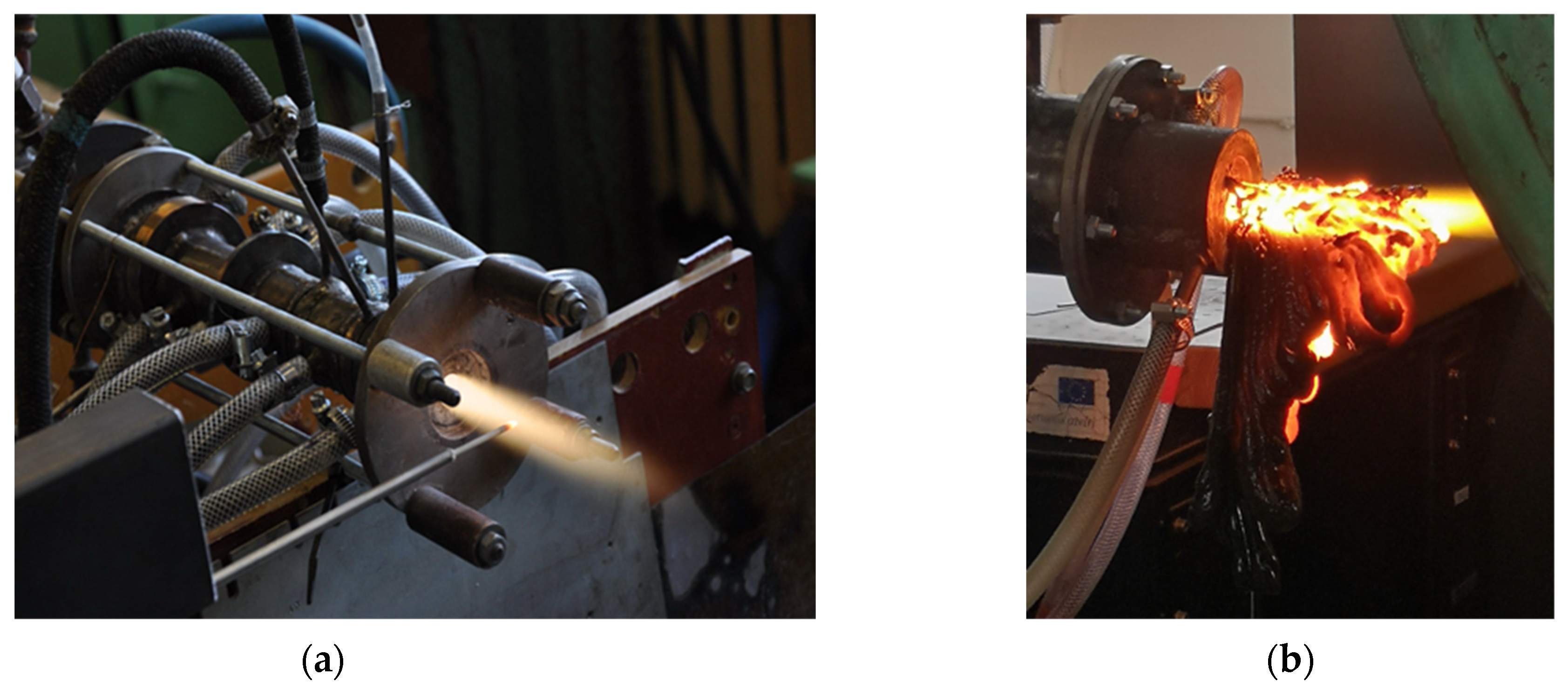
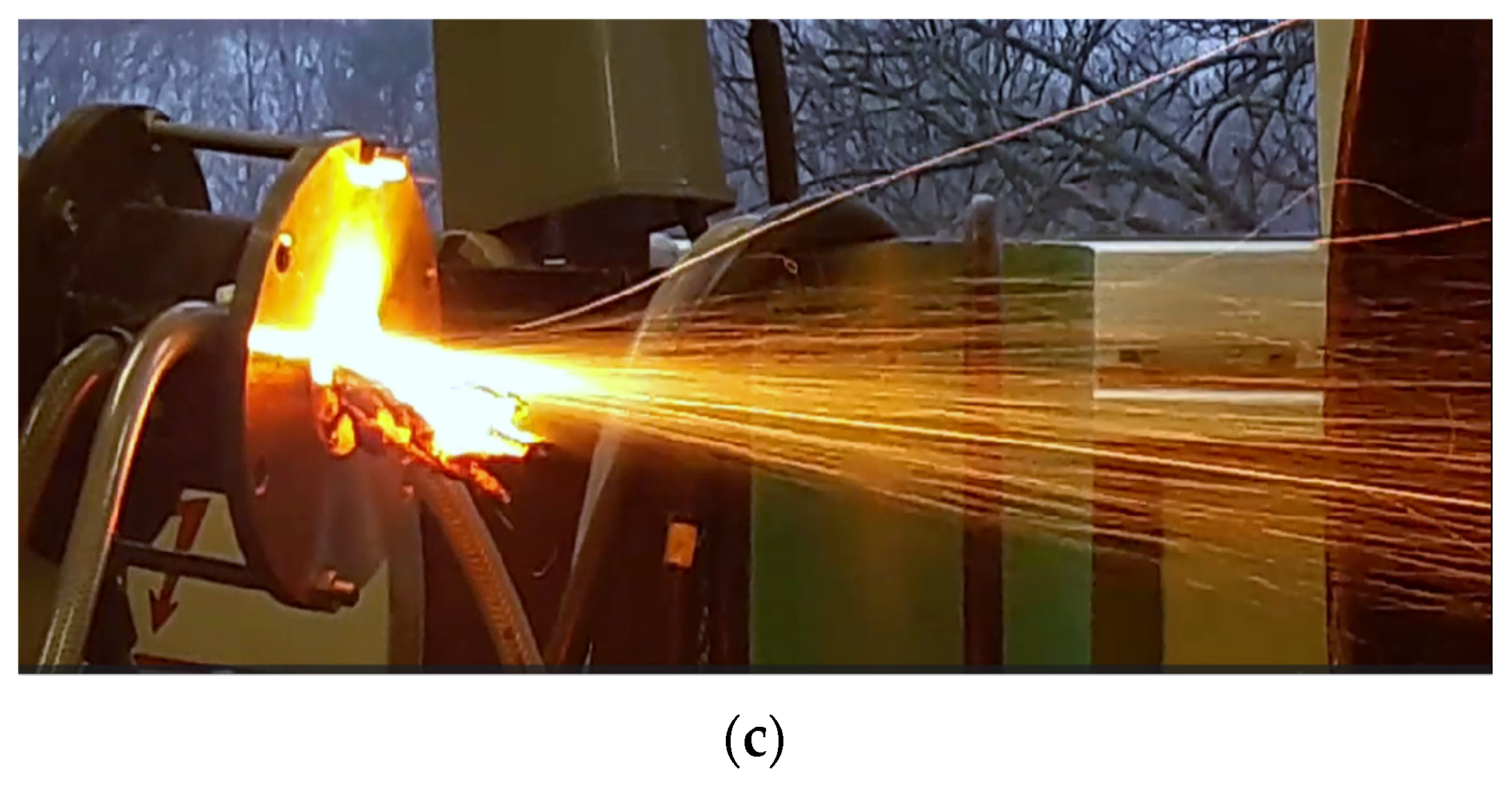
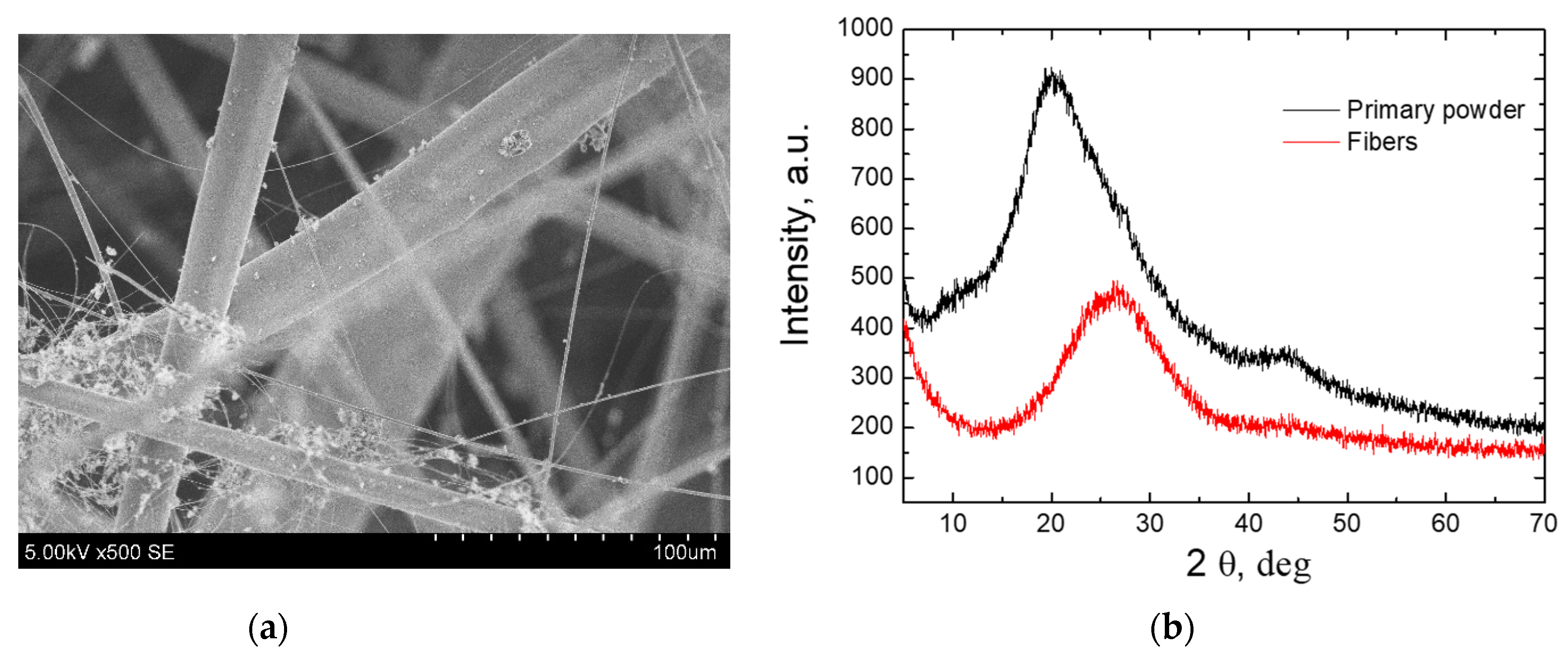
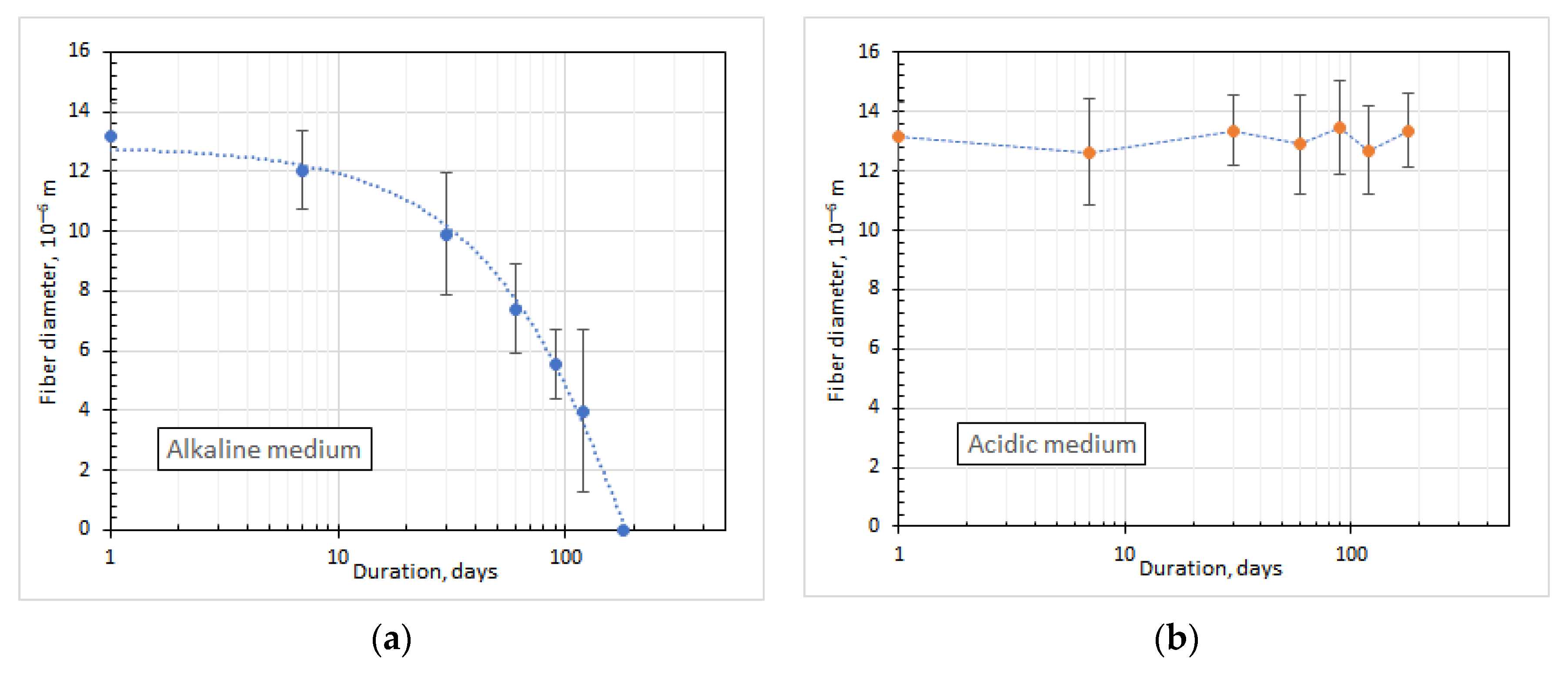

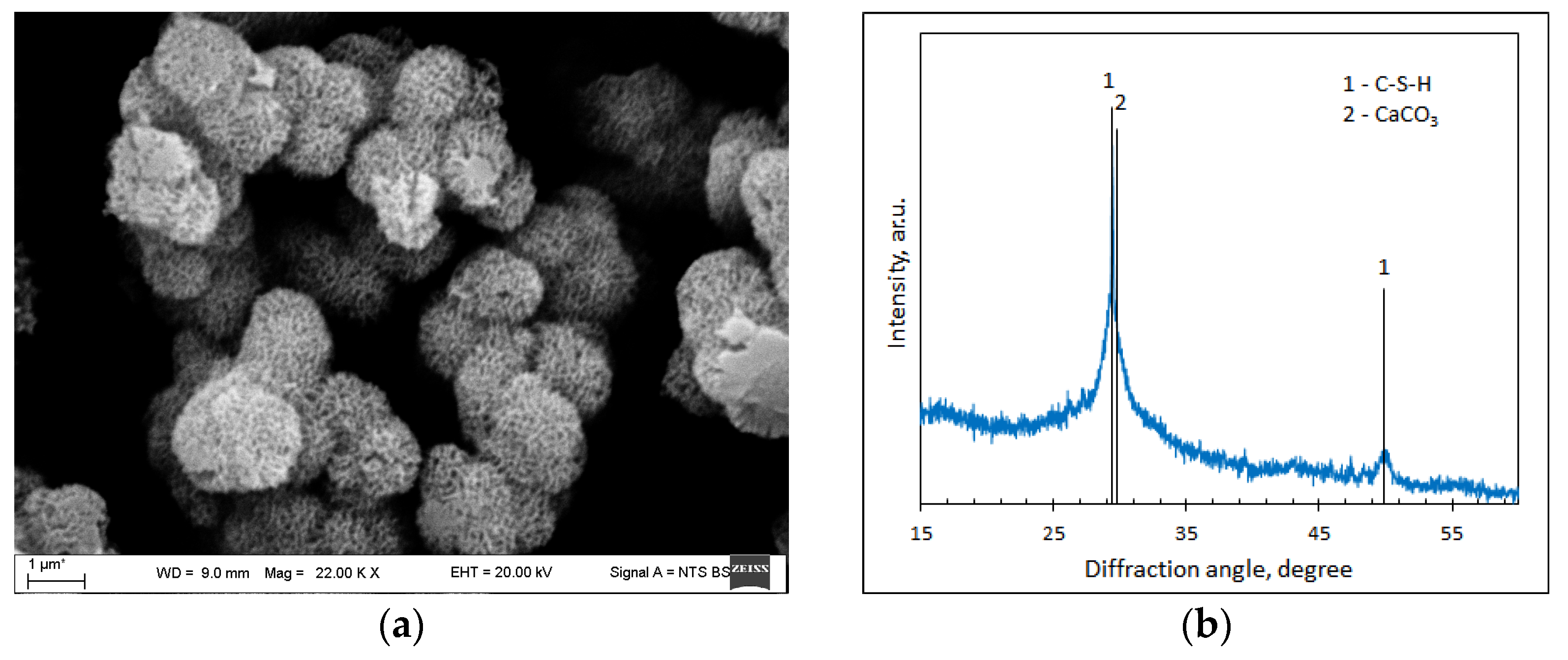
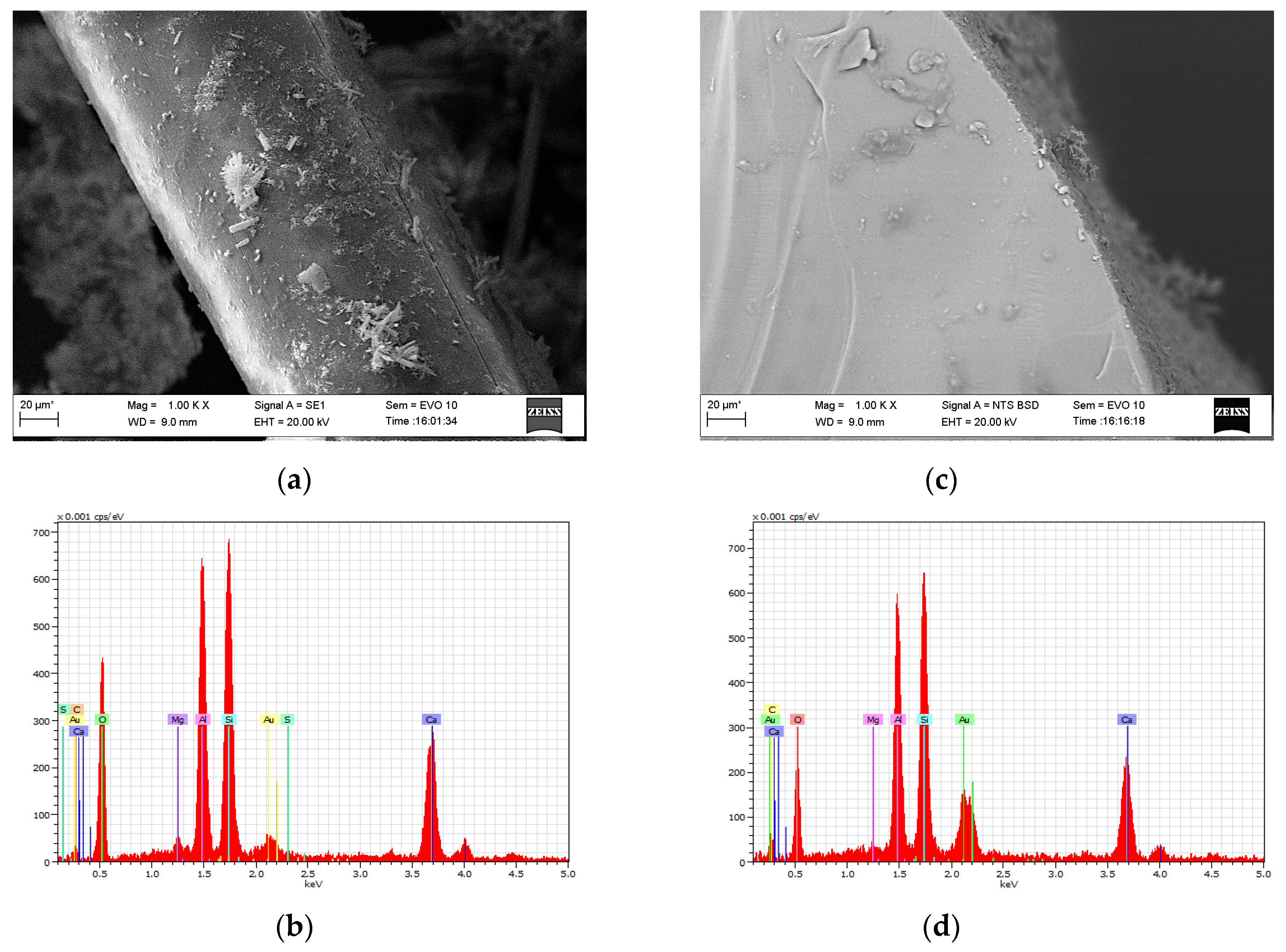
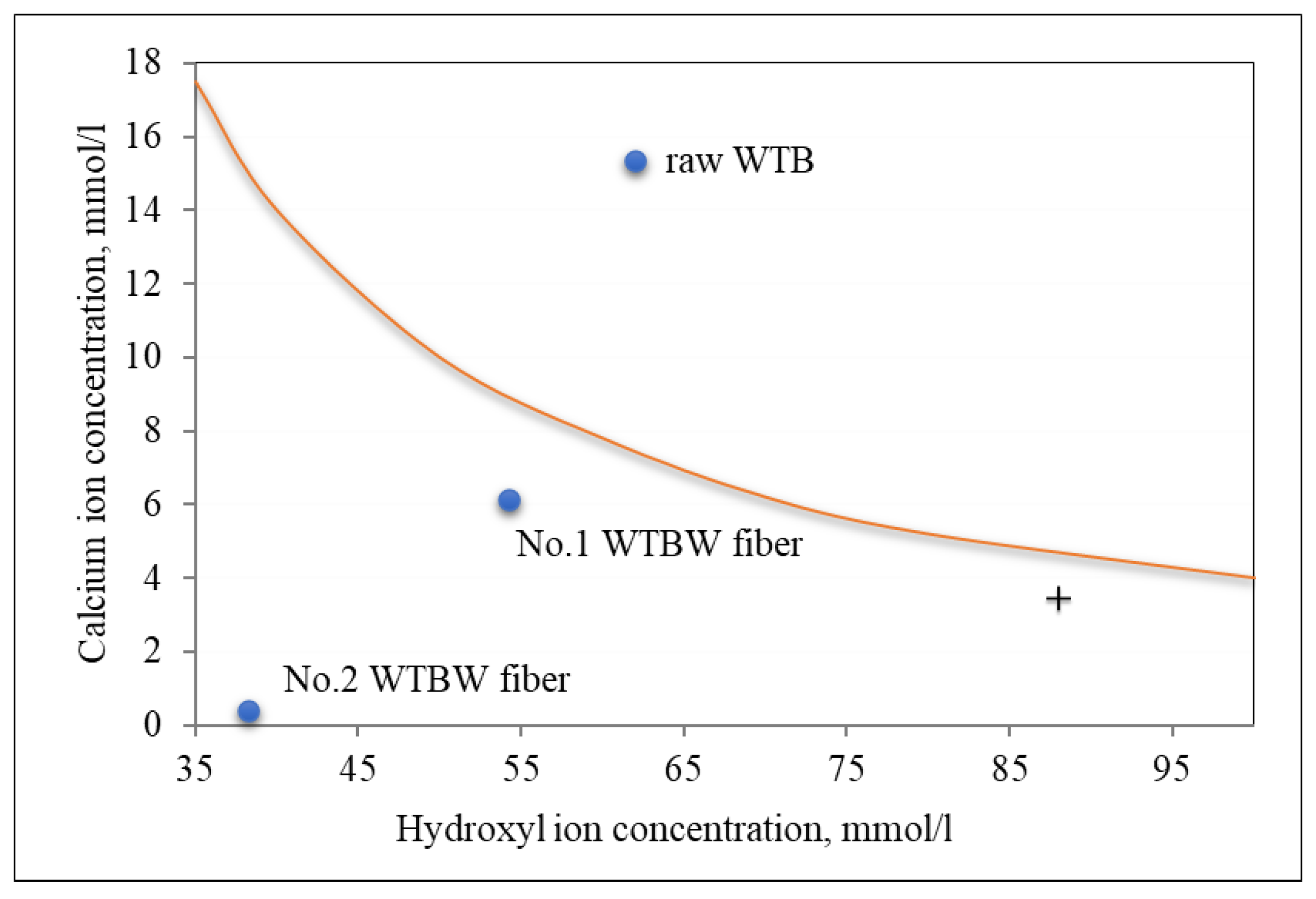
| Reference | Process Details | Recovered Fiber Properties | Effect on Fiber |
|---|---|---|---|
| R. S. Ginder et al. [34] | One-step pyrolysis 40 min at 450 °C; | Compared to virgin fiber, reduced Young’s modulus | Fiber without char |
| Two-step pyrolysis 30 min at 350 °C and 10 min 450 °C | Compared to virgin fiber, improved residual strength | Fiber without char | |
| B. Zhang et al. [37] | Pyrolysis in N2 at 380 and 450 °C for 120 min; pyrolysis in air at 450, 480, and 550 °C for 120 min | Compared to the original fiber, tensile strength reduced by 25% in N2; more than 50% in air | Fiber with char after pyrolysis in N2, no contamination after air pyrolysis |
| Y. Zhang et al. [38] | One-step pyrolysis: 10 min at selected temperatures (400, 500, 600, and 700 °C) with subsequent oxidation for 20 min | Not indicated | Clean fiber after longer oxidation or temperatures above 500 °C |
| S. Yousef et al. [36] | One-step pyrolysis at 500, 550, and 600 °C for 45–77 min | Not indicated | Fibers with char |
| M. Xu et al. [42] | WTB impregnation with glacial acetic acid before pyrolysis at 300–500 °C for 60 min followed by oxidation at 500 °C for 30 min | Compared to the original WTB fiber, the tensile strength of acid-pretreated recovered fiber increased by 28.3% | Fibers without char |
| M. Xu et al. [39] | Pyrolysis at 500 °C for 60 min: (a) pure N2, (b) 20% of H2O with N2, and (c) 20% of CO2 with N2. Pyrolysis without (i) and with post-oxidation at 500 °C for 30 min (ii). | Post-oxidation reduced tensile strength by 5.97% | Without post-oxidation, fibers covered with char After post-oxidation, clean the white fibers |
| L. Li at al. [40] | Single pyrolysis with the introduction of oxygen-containing exhaust gas; 60 min Stepwise pyrolysis—first pyrolysis for 30 min with subsequent oxidation for 30 min. Process temperature 550 °C | No difference in recovered fiber strength between processes. Reduction in Young’s modulus after single-step processing. | Structural damage on the surface of the recovered fiber |
| G. Cheng et al. [41] | Pyrolysis at simulated flue gas (N2 + O2 + SO2); temperature 380–480 °C; duration 2–6 h | Compared with fresh fiber, tensile strength decreases up to 10% when temperatures exceed 420 °C and reduces 5% when exposure times increase | Below 420 °C—fiber contaminated with char; above 420—non-contaminated fiber |
| A. Rahimizadeh et al. [43] | Pyrolysis at 550 °C for 45 min in N2 followed by an oxidative stage at 550 °C for 10 min | Relative to the ground fibers the tensile strength of the pyrolyzed fibers was reduced by 50% while stiffness was 9 to 17% higher. | Fiber without char |
| Reference | Type | WTBW Type | WTBW Content | Impact on Properties | |
|---|---|---|---|---|---|
| Increase | Decrease | ||||
| Ortega-López et al. [58] | Additive | Raw-crushed WTB | 1.5%, 3.0%, 4.5%, 6.0% | Ductility; load-bearing capacity | |
| Revilla-Cuesta et al. [63] | Additive | Raw-crushed WTB | 1.5% and 6.0% | Flexural strength; compressive strength | |
| Abdo et al. [61] | Coarse aggregate substitute | Needle shapes 60 × 60 × 50 mm | 2.5% | Tensile strength | Compressive strength |
| Xu et al. [64] | Additive | Macro fibers of lengths < 100 mm | 0.5%, 1.5%, 2.5% | Flexural strength; flexural toughness | Compressive strength |
| Baturkin et al. [51] | Coarse aggregate or cement substitute | Fine powder and 20 × 20 mm | 10%, and 20 wt% of cement or 50%, 100 vol% of aggregates | Compressive strength | |
| Fu et al. [65] | Additive | Macro fibers | 0.5%, 1.0%, 1.5% | Flexural strength; flexural toughness | Workability |
| Yazdanbakhsh et al. [66] | Coarse aggregate substitute | Square needles one inch thick, featuring both plain and grooved surfaces | 5% and 10% | Compressive strength | Workability; tensile strength; flexural strength |
| Yazdanbakhsh et al. [59] | Coarse aggregate substitute | GFRP needles of Ø 6 mm and a length of 100 mm | 5% and 10% | Tensile strength; energy absorption capacity | Compressive strength |
| Yazdanbakhsh et al. [67] | Coarse aggregate substitute | Cylindrical needles with an aspect ratio of 1 | 40% and 100% | Compressive strength; tensile strength | |
| Sorathiya et al. [68] | Coarse aggregate substitute | Cubes 20–25 mm | 20%, 40%, 60%, 80%, 100% | Compressive strength | |
| Farinha et al. [69] | Additive in mortar | Powder | Not indicated | Workability; required water; flexural strength; compressive strength | Density; water absorption; porosity |
| Oliveira et al. [70] | Additive in mortar | Powder | Not indicated | Required water; voids | Flexural strength; compressive strength density |
| Rodin et al. [71] | Additive in mortar | Powder and fiber | Not indicated | Flexural strength | Compressive strength |
| Reference | Type | Activator | WTBW Content | WTBW Type | Findings |
|---|---|---|---|---|---|
| B. Figiela et al. [77] | Lightweight material | 8 M and 10 M sodium hydroxide solution | 25–75 wt% | Fiber length less than 1 mm | The higher content of WTB the lower strength and higher porosity |
| K. Plawecka et al. [78] | Composite | 8 M and 10 M sodium hydroxide solution | 5; 15; 30 wt% | Mixture of fibers and powder particles (0.05–1 mm) after pre-treatment at 600 °C for 12 h | Filler deteriorates properties of the geopolymer material |
| L. Senff et al. [79] | Foam material | 10 M sodium hydroxide solution | 1–2 wt% | Fiber length 6 mm | Fibers strengthen the structure of foamed material; a minor effect on thermal conductivity |
| R. M. Novais et al. [80] | Composite | Sodium silicate solution | 0–3 wt% | Fiber length 6 and 20 mm | Higher content of shorter fibers increases the performance of geopolymers |
| M. Zhang et al. [81] | Foamed lightweight material | Sodium silicate solution | 2, 4, 6 wt% | Fiber length 1.45–4.75 mm | 6% of fiber increases compressive strength, reduces drying shrinkage, increases thermal conductivity |
| Element | Recovered Fiber | Fiber After 120 Days | |
|---|---|---|---|
| (wt%) | Alkaline | Acid | |
| Si | 23.6 | 25.68 | 22.56 |
| Ca | 22.89 | 21.45 | 20.98 |
| Al | 6.58 | 7.1 | 6.75 |
| Mg | 1.51 | 1.8 | 1.48 |
| K | 0.59 | 0.38 | 0.47 |
| Ti | 0.22 | 0.4 | 0.22 |
| Fe | 0.14 | 0.32 | 0.28 |
| Na | 0.18 | 0.28 | 0.34 |
| P | - | - | 0.25 |
| C | 4.13 | 3.83 | 4.12 |
| Ca/Si | 0.97 | 0.84 | 0.93 |
| Oxides (wt%) | Raw Fiber [80] | Recovered Fiber | Sediments After 180 Days | |
|---|---|---|---|---|
| in Alkalis | in Acid | |||
| SiO2 | 51.01 | 50.49 | 31.87 | 41.05 |
| Al2O3 | 12.20 | 12.43 | 0.70 | 8.92 |
| CaO | 22.82 | 32.03 | 31.93 | 18.22 |
| MgO | 2.95 | 2.50 | 0.30 | 1.48 |
| Na2O | 0.16 | 0.24 | 0.15 | 0.58 |
| K2O | 0.88 | 0.71 | 0.07 | 0.52 |
| TiO2 | 0.32 | 0.37 | 0.15 | 0.30 |
| Fe2O3 | 0.32 | 0.20 | 0.71 | 0.24 |
| P2O5 | 0.08 | - | - | 13.04 |
| Oxides (wt%) | Basalt Fiber [95] | Recycled Fiber [53] | Aged Fiber After 550 Days (Data of This Study) | |
|---|---|---|---|---|
| Surface | Cross-Section | |||
| SiO2 | 54.7 | 36.4 | 33.24 | 29.59 |
| Al2O3 | 20.9 | 19.9 | 28.55 | 24.90 |
| CaO | 7.0 | 18.5 | 19.91 | 17.88 |
| MgO | 5.1 | 0.88 | 1.36 | 0.78 |
| Na2O | 2.4 | 0.19 | 0.01 | - |
| K2O | 1.6 | 0.13 | 0.02 | - |
| TiO2 | 0.8 | 0.69 | - | - |
| Fe2O3 | 7.6 | 0.47 | - | - |
| P2O5 | - | 0.38 | - | - |
Disclaimer/Publisher’s Note: The statements, opinions and data contained in all publications are solely those of the individual author(s) and contributor(s) and not of MDPI and/or the editor(s). MDPI and/or the editor(s) disclaim responsibility for any injury to people or property resulting from any ideas, methods, instructions or products referred to in the content. |
© 2025 by the authors. Licensee MDPI, Basel, Switzerland. This article is an open access article distributed under the terms and conditions of the Creative Commons Attribution (CC BY) license (https://creativecommons.org/licenses/by/4.0/).
Share and Cite
Kalpokaitė-Dičkuvienė, R.; Snapkauskienė, V. Prospects for the Valorization of Wind Turbine Blade Waste: Fiber Recovery and Recycling. Sustainability 2025, 17, 4202. https://doi.org/10.3390/su17094202
Kalpokaitė-Dičkuvienė R, Snapkauskienė V. Prospects for the Valorization of Wind Turbine Blade Waste: Fiber Recovery and Recycling. Sustainability. 2025; 17(9):4202. https://doi.org/10.3390/su17094202
Chicago/Turabian StyleKalpokaitė-Dičkuvienė, Regina, and Vilma Snapkauskienė. 2025. "Prospects for the Valorization of Wind Turbine Blade Waste: Fiber Recovery and Recycling" Sustainability 17, no. 9: 4202. https://doi.org/10.3390/su17094202
APA StyleKalpokaitė-Dičkuvienė, R., & Snapkauskienė, V. (2025). Prospects for the Valorization of Wind Turbine Blade Waste: Fiber Recovery and Recycling. Sustainability, 17(9), 4202. https://doi.org/10.3390/su17094202







